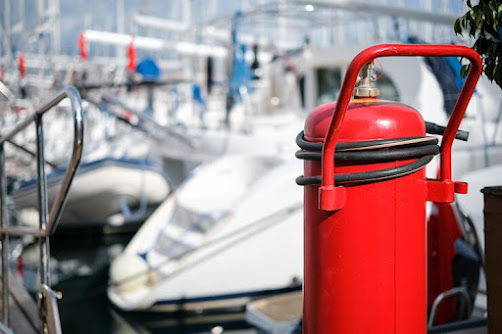Keeping the Flames at Bay: Professional Fire Extinguisher Servicing
Introduction
Fire extinguishers stand as stalwart defenders against the unpredictable nature of fires, but their efficacy hinges on proper maintenance and servicing. In this comprehensive guide, we delve into the intricate world of professional fire extinguisher servicing – exploring why it's crucial, what it entails, and the indispensable role it plays in preserving the functionality of these indispensable safety devices.
The Vital Role of Professional Fire Extinguisher Servicing
Professional fire extinguisher servicing goes beyond routine inspections; it involves a thorough examination by certified technicians to ensure that these life-saving devices remain in optimal working condition. The significance of this service lies in several key aspects:
Reliability: Regular servicing guarantees the reliability of fire extinguishers, ensuring they function as intended during a fire emergency.
Compliance: Professional servicing ensures that fire extinguishers comply with local regulations and standards, safeguarding against potential legal ramifications.
Extended Lifespan: Routine servicing can extend the lifespan of fire extinguishers, providing prolonged protection for homes, businesses, and public spaces.
Early Detection of Issues: Certified technicians are trained to detect issues that may go unnoticed during routine inspections, facilitating prompt repairs and maintenance.
Optimal Performance: Servicing includes discharging and recharging extinguishers if necessary, ensuring the extinguishing agent is at the proper pressure for effective fire suppression.
What Does Professional Fire Extinguisher Servicing Encompass?
Professional fire extinguisher servicing is a comprehensive process that addresses various components and aspects of these critical safety devices. Here's a breakdown of what it typically encompasses:
1. Visual Inspection
Certified technicians initiate the servicing process with a detailed visual inspection. This includes checking for external damage such as dents, corrosion, or leakage. The visual inspection sets the stage for a more in-depth assessment of the extinguisher's condition.
2. Pressure Gauge Check
The pressure gauge is a crucial component of a fire extinguisher, indicating whether the extinguisher is charged and ready for use. Technicians check the pressure gauge to ensure it falls within the acceptable operating range. If the pressure is too high or too low, it may signify a problem with the extinguisher.
3. Internal Component Examination
Technicians delve into the internal components of the fire extinguisher, inspecting valves, hoses, and other vital parts. This examination ensures that all components are in good working condition and capable of facilitating effective fire suppression.
4. Discharge and Recharge (if necessary)
As part of the servicing process, technicians may discharge and recharge the extinguisher. This involves releasing the extinguishing agent and then refilling it to the appropriate pressure. Discharge and recharge are essential for maintaining optimal performance.
5. Hydrostatic Testing
Certain types of fire extinguishers, particularly those with metal cylinders, may undergo hydrostatic testing. This test involves pressurizing the cylinder with water to check for leaks or structural weaknesses. Hydrostatic testing is typically conducted every few years, depending on the type of extinguisher.
6. Compliance Verification
Certified technicians ensure that the fire extinguisher complies with local regulations and standards. Compliance verification is crucial for businesses and organizations to meet safety requirements and avoid potential penalties.
7. Documentation
Technicians provide documentation of the servicing process, detailing the date of service, any issues identified, and the actions taken. This documentation serves as a record of compliance and maintenance history.
Frequency of Professional Fire Extinguisher Servicing
The frequency of professional fire extinguisher servicing depends on various factors, including the type of extinguisher, its environment, and local regulations. Here's a general guideline:
Annual Servicing: Fire extinguishers should undergo professional servicing at least once a year. This comprehensive examination ensures that all components are thoroughly checked, and any necessary maintenance is performed.
More Frequent Servicing: In certain environments with higher risks or heavy usage, more frequent servicing may be recommended. This could be quarterly or semi-annual servicing to maintain optimal performance.
Hydrostatic Testing Schedule: If a fire extinguisher requires hydrostatic testing, this is typically done every five years. The specific schedule may vary based on local regulations and the type of extinguisher.
The DIY Fire Extinguisher Servicing Guide
While professional servicing is indispensable, users can perform basic checks between professional visits to ensure the ongoing functionality of their fire extinguishers. Here's a simple DIY guide:
Visual Inspection: Regularly inspect the exterior of the extinguisher for any visible signs of damage, including dents, corrosion, or leakage.
Pressure Gauge Check: Check the pressure gauge to ensure it falls within the acceptable operating range. Most extinguishers have a green zone on the gauge indicating proper pressure.
Safety Pin and Tamper Seal: Verify that the safety pin is intact, and the tamper seal is unbroken. Broken seals may indicate that the extinguisher has been used or tampered with.
Accessibility: Confirm that the extinguisher is in its designated location, easily visible, and unobstructed.
Documentation: Keep a record of any issues identified during the DIY checks. This information can be valuable during professional servicing and compliance checks.
The Value of Certified Technicians
Certified technicians bring a wealth of knowledge and expertise to the fire extinguisher servicing process. Their training ensures that they can identify subtle issues that may go unnoticed during routine inspections, offering a level of precision that is crucial for maintaining optimal performance.
Moreover, certified technicians adhere to industry standards and regulations, ensuring that the servicing process is conducted with the utmost professionalism and compliance. Their insights and recommendations contribute to the overall safety and preparedness of the environments in which fire extinguishers are deployed.
Conclusion
Professional fire extinguisher service is an integral component of fire safety, contributing to the reliability, compliance, and longevity of these critical safety devices. By understanding the comprehensive nature of professional servicing, individuals and organizations can prioritize the wellness of their fire extinguishers, thereby enhancing overall safety and preparedness.




Comments
Post a Comment